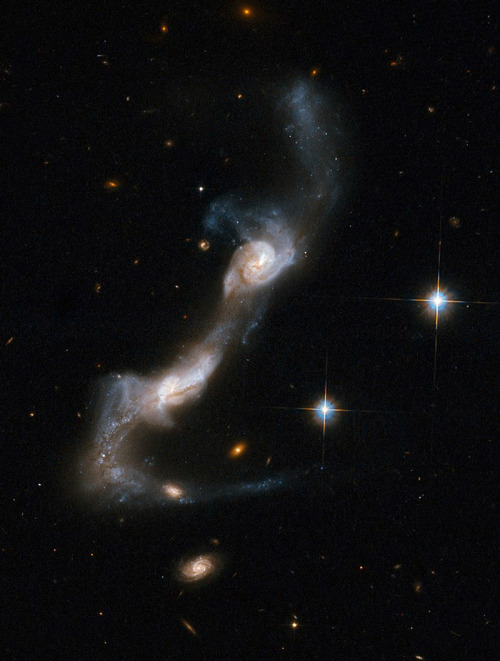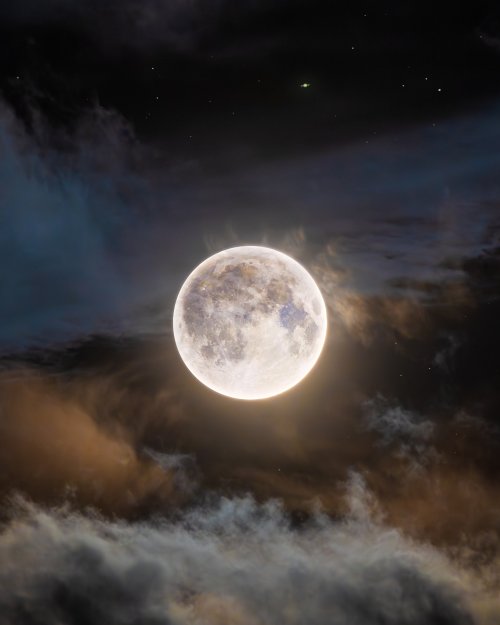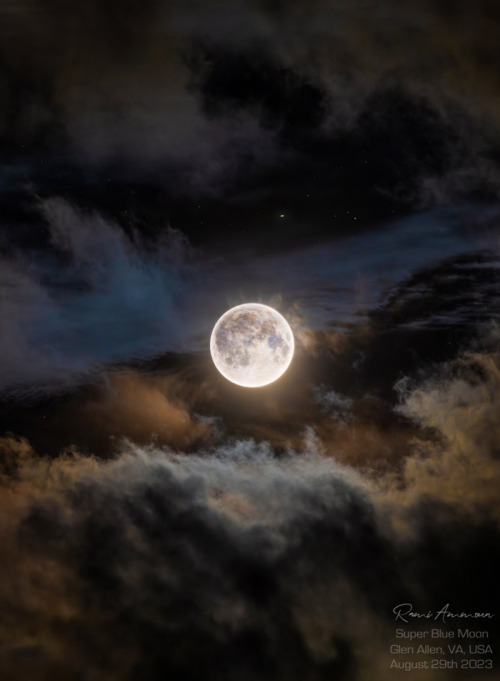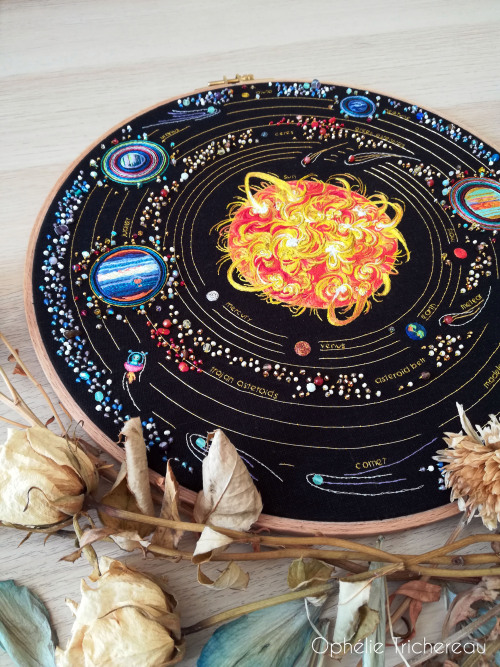2023 September 28

2023 September 28
The Deep Lagoon Image Credit & Copyright: Josep Drudis, Christian Sasse
Explanation: Ridges of glowing interstellar gas and dark dust clouds inhabit the turbulent, cosmic depths of the Lagoon Nebula. Also known as M8, The bright star forming region is about 5,000 light-years distant. It makes for a popular stop on telescopic tours of the constellation Sagittarius toward the center of our Milky Way Galaxy. Dominated by the telltale red emission of ionized hydrogen atoms recombining with stripped electrons, this deep telescopic view of the Lagoon’s central reaches is about 40 light-years across. The bright hourglass shape near the center of the frame is gas ionized and sculpted by energetic radiation and extreme stellar winds from a massive young star.
∞ Source: apod.nasa.gov/apod/ap230928.html
More Posts from Ad-astra-affecte-spe and Others
Cosmic Alphabet Soup: Classifying Stars

If you’ve spent much time stargazing, you may have noticed that while most stars look white, some are reddish or bluish. Their colors are more than just pretty – they tell us how hot the stars are. Studying their light in greater detail can tell us even more about what they’re like, including whether they have planets. Two women, Williamina Fleming and Annie Jump Cannon, created the system for classifying stars that we use today, and we’re building on their work to map out the universe.

By splitting starlight into spectra – detailed color patterns that often feature lots of dark lines – using a prism, astronomers can figure out a star’s temperature, how long it will burn, how massive it is, and even how big its habitable zone is. Our Sun’s spectrum looks like this:

Astronomers use spectra to categorize stars. Starting at the hottest and most massive, the star classes are O, B, A, F, G (like our Sun), K, M. Sounds like cosmic alphabet soup! But the letters aren’t just random – they largely stem from the work of two famous female astronomers.

Williamina Fleming, who worked as one of the famous “human computers” at the Harvard College Observatory starting in 1879, came up with a way to classify stars into 17 different types (categorized alphabetically A-Q) based on how strong the dark lines in their spectra were. She eventually classified more than 10,000 stars and discovered hundreds of cosmic objects!

That was back before they knew what caused the dark lines in spectra. Soon astronomers discovered that they’re linked to a star’s temperature. Using this newfound knowledge, Annie Jump Cannon – one of Fleming’s protégés – rearranged and simplified stellar classification to include just seven categories (O, B, A, F, G, K, M), ordered from highest to lowest temperature. She also classified more than 350,000 stars!

Type O stars are both the hottest and most massive in the new classification system. These giants can be a thousand times bigger than the Sun! Their lifespans are also around 1,000 times shorter than our Sun’s. They burn through their fuel so fast that they only live for around 10 million years. That’s part of the reason they only make up a tiny fraction of all the stars in the galaxy – they don’t stick around for very long.

As we move down the list from O to M, stars become progressively smaller, cooler, redder, and more common. Their habitable zones also shrink because the stars aren’t putting out as much energy. The plus side is that the tiniest stars can live for a really long time – around 100 billion years – because they burn through their fuel so slowly.

Astronomers can also learn about exoplanets – worlds that orbit other stars – by studying starlight. When a planet crosses in front of its host star, different kinds of molecules in the planet’s atmosphere absorb certain wavelengths of light.
By spreading the star’s light into a spectrum, astronomers can see which wavelengths have been absorbed to determine the exoplanet atmosphere’s chemical makeup. Our James Webb Space Telescope will use this method to try to find and study atmospheres around Earth-sized exoplanets – something that has never been done before.

Our upcoming Nancy Grace Roman Space Telescope will study the spectra from entire galaxies to build a 3D map of the cosmos. As light travels through our expanding universe, it stretches and its spectral lines shift toward longer, redder wavelengths. The longer light travels before reaching us, the redder it becomes. Roman will be able to see so far back that we could glimpse some of the first stars and galaxies that ever formed.
Learn more about how Roman will study the cosmos in our other posts:
Roman’s Family Portrait of Millions of Galaxies
New Rose-Colored Glasses for Roman
How Gravity Warps Light
Make sure to follow us on Tumblr for your regular dose of space!

The Seagull Nebula © Gianni Lacroce

Cosmic Dance of Spiral Galaxies: Arp 238
Uranus- JWST NIRCam

This image also shows 14 of the planet’s 27 moons: Oberon, Titania, Umbriel, Juliet, Perdita, Rosalind, Puck, Belinda, Desdemona, Cressida, Ariel, Miranda, Bianca, and Portia.

This picture shows Uranus's north polar cap as well as a storm just below the polar edge.

A stellar exodus was caught in action! Astronomers used the Hubble Space Telescope to watch the white dwarf exodus in the globular star cluster 47 Tucanae, a dense swarm of hundreds of thousands of stars in our Milky Way galaxy. Hubble took snapshots of fledgling white dwarf stars beginning their slow-paced, 40-million-year migration from the crowded center of an ancient star cluster to the less populated suburbs. By observing ultraviolet light, astronomers examined 3,000 white dwarfs, tracing two populations with diverse ages and orbits. One grouping was 6 million years old and had just begun their journey. Another was around 100 million years old and had already arrived at its new homestead far from the center, roughly 1.5 light-years, or nearly 9 trillion miles (14 trillion kilometers), away. The cluster resides 14,500 light-years away in the southern constellation Tucana. Credit: NASA, ESA, and H. Richer and J. Heyl (University of British Columbia, Vancouver, Canada). ALT TEXT: Thousands of stars, seen as tiny dots, are shown on a black background. The stars vary in size and color, including orange, yellow, and white.

Boo! Did we get you? 🎃
This solar jack-o-lantern, captured by our Solar Dynamics Observatory (SDO) in October 2014, gets its ghoulish grin from active regions on the Sun, which emit more light and energy than the surrounding dark areas. Active regions are markers of an intense and complex set of magnetic fields hovering in the sun’s atmosphere.
The SDO has kept an unblinking eye on the Sun since 2010, recording phenomena like solar flares and coronal loops. It measures the Sun’s interior, atmosphere, magnetic field, and energy output, helping us understand our nearest star.
Grab the high-resolution version here.
Make sure to follow us on Tumblr for your regular dose of space!



The 2nd full moon of August 2023 l Rami Ammoun
-
 astropantera reblogged this · 3 months ago
astropantera reblogged this · 3 months ago -
 astropantera liked this · 3 months ago
astropantera liked this · 3 months ago -
 starryfull13 reblogged this · 3 months ago
starryfull13 reblogged this · 3 months ago -
 melocosmos reblogged this · 9 months ago
melocosmos reblogged this · 9 months ago -
 melocosmos liked this · 9 months ago
melocosmos liked this · 9 months ago -
 blagueofchaos reblogged this · 11 months ago
blagueofchaos reblogged this · 11 months ago -
 alfhildr-the-word-weaver liked this · 11 months ago
alfhildr-the-word-weaver liked this · 11 months ago -
 fatherizzyisms liked this · 1 year ago
fatherizzyisms liked this · 1 year ago -
 jedilegacy3-blog liked this · 1 year ago
jedilegacy3-blog liked this · 1 year ago -
 astrodances reblogged this · 1 year ago
astrodances reblogged this · 1 year ago -
 astrodances liked this · 1 year ago
astrodances liked this · 1 year ago -
 tanukikawaii liked this · 1 year ago
tanukikawaii liked this · 1 year ago -
 titch29 liked this · 1 year ago
titch29 liked this · 1 year ago -
 fumi-domenico-mori liked this · 1 year ago
fumi-domenico-mori liked this · 1 year ago -
 seriih liked this · 1 year ago
seriih liked this · 1 year ago -
 beholdthepower0fmystand reblogged this · 1 year ago
beholdthepower0fmystand reblogged this · 1 year ago -
 jupejumble liked this · 1 year ago
jupejumble liked this · 1 year ago -
 feynmandavinci liked this · 1 year ago
feynmandavinci liked this · 1 year ago -
 marvi-jude94 liked this · 1 year ago
marvi-jude94 liked this · 1 year ago -
 brassassination reblogged this · 1 year ago
brassassination reblogged this · 1 year ago -
 brassassination liked this · 1 year ago
brassassination liked this · 1 year ago -
 moog190 liked this · 1 year ago
moog190 liked this · 1 year ago -
 cortex-cubeko liked this · 1 year ago
cortex-cubeko liked this · 1 year ago -
 nlockett reblogged this · 1 year ago
nlockett reblogged this · 1 year ago -
 nlockett liked this · 1 year ago
nlockett liked this · 1 year ago -
 elthedeuro reblogged this · 1 year ago
elthedeuro reblogged this · 1 year ago -
 itscomplicatedx reblogged this · 1 year ago
itscomplicatedx reblogged this · 1 year ago -
 itscomplicatedx liked this · 1 year ago
itscomplicatedx liked this · 1 year ago -
 bluestaratsunrise reblogged this · 1 year ago
bluestaratsunrise reblogged this · 1 year ago -
 bluestaratsunrise liked this · 1 year ago
bluestaratsunrise liked this · 1 year ago -
 70herozodi liked this · 1 year ago
70herozodi liked this · 1 year ago -
 daarni liked this · 1 year ago
daarni liked this · 1 year ago -
 fayefrogs liked this · 1 year ago
fayefrogs liked this · 1 year ago -
 tthel liked this · 1 year ago
tthel liked this · 1 year ago -
 the-yearning-astronaut reblogged this · 1 year ago
the-yearning-astronaut reblogged this · 1 year ago -
 keturahhsgf liked this · 1 year ago
keturahhsgf liked this · 1 year ago -
 blindbullseye liked this · 1 year ago
blindbullseye liked this · 1 year ago -
 wachsurfer2018 liked this · 1 year ago
wachsurfer2018 liked this · 1 year ago -
 almm-world liked this · 1 year ago
almm-world liked this · 1 year ago -
 flubbernuggetsj liked this · 1 year ago
flubbernuggetsj liked this · 1 year ago -
 miathebiweeb liked this · 1 year ago
miathebiweeb liked this · 1 year ago -
 dragonborn928 liked this · 1 year ago
dragonborn928 liked this · 1 year ago -
 crashalido reblogged this · 1 year ago
crashalido reblogged this · 1 year ago -
 crashalido liked this · 1 year ago
crashalido liked this · 1 year ago -
 natildragongirl liked this · 1 year ago
natildragongirl liked this · 1 year ago

★•Astronomy, Physics, and Aerospace•★ Original and Reblogged Content curated by a NASA Solar System Ambassador
204 posts















